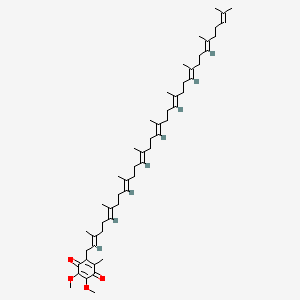| Authors | Title | Published | Journal | PubMed Link |
|---|---|---|---|---|
| Bae JS et al. | Apoptotic cell death of human leukaemia U937 cells by ubiquinone-9 purified from Pleurotus eryngii. | 2009 | Nat. Prod. Res. | pmid:19662576 |
| Comley JC et al. | Synthesis of ubiquinone 9 by adult Brugia pahangi and Dirofilaria immitis: evidence against its involvement in the oxidation of 5-methyltetrahydrofolate. | 1981 | Mol. Biochem. Parasitol. | pmid:7242567 |
| Armeni T et al. | Dietary restriction affects antioxidant levels in rat liver mitochondria during ageing. | 1997 | Mol. Aspects Med. | pmid:9266530 |
| Vadhanavikit S and Ganther HE | Selenium deficiency and decreased coenzyme Q levels. | 1994 | Mol. Aspects Med. | pmid:7752821 |
| Loop RA et al. | Effects of ethanol, lovastatin and coenzyme Q10 treatment on antioxidants and TBA reactive material in liver of rats. | 1994 | Mol. Aspects Med. | pmid:7752831 |
| Mataix J et al. | Coenzyme Q content depends upon oxidative stress and dietary fat unsaturation. | 1997 | Mol. Aspects Med. | pmid:9266514 |
| Youngman LD et al. | Effects of a peroxisomal proliferator (PP) on plasma and tissue levels of coenzyme Q9 (CoQ), other antioxidants, and oxidative damage to DNA (oxo8dG): evidence that PPs deplete antioxidants and increase oxidative damage to DNA. | 1994 | Mol. Aspects Med. | pmid:7752824 |
| Kishi T et al. | Cytosolic NADPH-UQ reductase-linked recycling of cellular ubiquinol: its protective effect against carbon tetrachloride hepatotoxicity in rat. | 1997 | Mol. Aspects Med. | pmid:9266508 |
| Willis RA et al. | The effect of ethanol and/or food restriction on coenzyme Q in liver in rats. | 1997 | Mol. Aspects Med. | pmid:9266523 |
| Castelluccio C et al. | Coenzyme Q changes in liver and plasma in the rat after partial hepatectomy. | 1997 | Mol. Aspects Med. | pmid:9266536 |
Coenzyme Q9
Coenzyme q9 is a lipid of Prenol Lipids (PR) class. The involved functions are known as Diastasis, Phosphorylation and Cardiac function.
Cross Reference
Introduction
To understand associated biological information of Coenzyme Q9, we collected biological information of abnormalities, associated pathways, cellular/molecular locations, biological functions, related genes/proteins, lipids and common seen animal/experimental models with organized paragraphs from literatures.
What diseases are associated with Coenzyme Q9?
There are no associated biomedical information in the current reference collection.
No disease MeSH terms mapped to the current reference collection.
PubChem Associated disorders and diseases
What pathways are associated with Coenzyme Q9
There are no associated biomedical information in the current reference collection.
PubChem Biomolecular Interactions and Pathways
Link to PubChem Biomolecular Interactions and PathwaysWhat cellular locations are associated with Coenzyme Q9?
There are no associated biomedical information in the current reference collection.
What functions are associated with Coenzyme Q9?
Related references are published most in these journals:
| Function | Cross reference | Weighted score | Related literatures |
|---|
What lipids are associated with Coenzyme Q9?
There are no associated biomedical information in the current reference collection.
What genes are associated with Coenzyme Q9?
There are no associated biomedical information in the current reference collection.
What common seen animal models are associated with Coenzyme Q9?
There are no associated biomedical information in the current reference collection.
